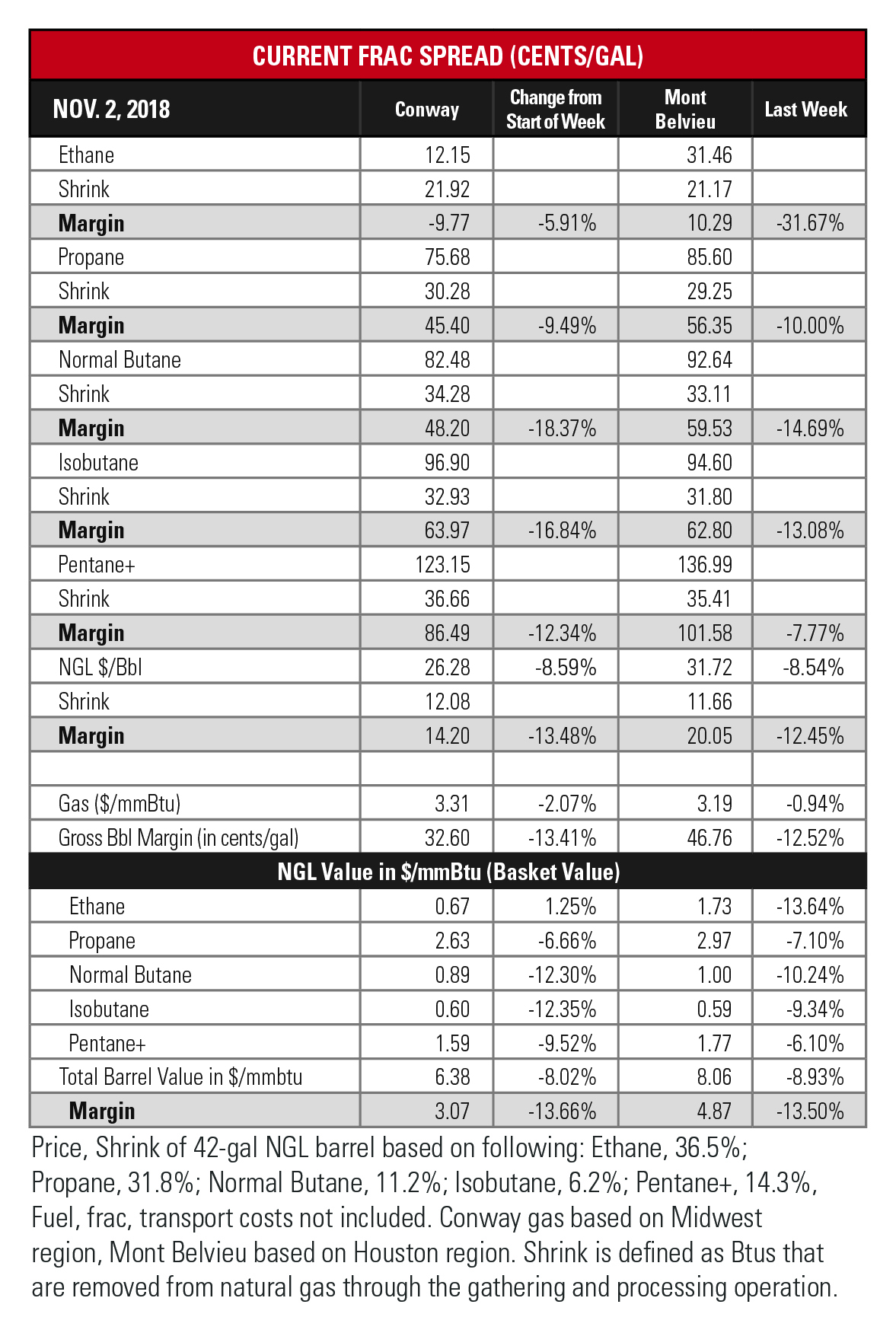
As crude oil goes, so go prices throughout the fossil fuel realm. And lately, they’ve all been going down.
U.S. benchmark West Texas Intermediate (WTI) sagged to a two-month low on Oct. 30 as crude inventories continued to rise for the sixth straight week. Brent took a 1.8% hit on Oct. 30, though it stabilized on Halloween.
The Mont Belvieu, Texas, hypothetical barrel fell 8.5% in the past week as ethane (down 13.6%) and normal butane (down 10.2%) tumbled. In fact, Conway, Kan., ethane was the only NGL tracked by Hart Energy to increase in price, rising by 1.3%.

Bleak as the numbers appear, the outlook is not a gloomy one. EnVantage Inc. even feels good about it.
“We feel that the current correction in crude prices is a healthy development for the crude markets,” the analysts wrote in a report. “Talk of $100 crude was being bandied about. Oil prices were definitely getting overheated and if crude did surge to $100 it would have done considerably more damage to global economic growth.”
EnVantage expects market fundamentals to support WTI prices at around $64 to $65 (the midday price on Oct. 31 was $66.26). Among their reasons:
- U.S. refinery turnarounds will end, which will slow the build in inventories;
- Exports will benefit from the wide price spread between Brent and WTI ($9.57 at midday Oct. 31);
- U.S. sanctions on Iran are set to become effective on Nov. 5;
- If the Saudis increase oil production to offset the decline in Iranian exports, as promised, global spare production capacity becomes very tight; and
- The possibility of sanctions against Saudi Arabia over the murder of journalist and dissident Jamal Khashoggi could further destabilize the Middle East.
The low oil prices have been a drag on NGL in general. Mont Belvieu’s barrel is off 23.8% since cresting near $42 per barrel (bbl) at the start of October, and EnVantage believes the lower prices of propane and normal butane are forcing ethane’s price to decline before it loses its advantage as the most economical feedstock.

Unscheduled ethylene plant outages, struggling flexi-crackers and planned turnarounds aren’t helping, either. The analysts estimate that Gulf Coast cracking demand is down by 100,000 barrels per day. Exports, however, are up slightly over September’s shipments.
Natural gas prices, however, are holding strong, which is cutting deeply into margins. Mont Belvieu’s ethane margin tightened from 15 cents per gallon (gal) last week to just over 10 cents/gal in the past week. Because Mont Belvieu’s fractionation capacity remains tight, said EnVantage, ethane rejection is on the rise.
EnVantage estimates ethane rejection west of the Marcellus-Utica and could be as high as 400,000 bbl/d. The analysts note that first-half 2019 could see as much as 300,000 bbl/d of new cracking capacity coming online. Volumes of ethane stored in Gulf Coast salt domes could fall well below 30 million barrels. The result: ethane prices that could soar to 60 cents/gal in the first six months of 2019.

In the week ended Oct. 26, storage of natural gas in the Lower 48 experienced an increase of 48 billion cubic feet (Bcf), the U.S. Energy Information Administration reported, compared to the Bloomberg survey’s 51 Bcf. The figure resulted in a total of 3.143 trillion cubic feet (Tcf). That is 16.5% below the 3.766 Tcf figure at the same time in 2017 and 16.9% below the five-year average of 3.781 Tcf.
Joseph Markman can be reached at jmarkman@hartenergy.com or @JHMarkman.
Recommended Reading
Inside Ineos’ US E&P Business Plan: Buy, Build, Buy
2025-01-27 - The E&P chief of U.K.’s Ineos says its oily Eagle Ford Shale acquisition in 2023 has been a profitable platform entry for its new U.S. upstream business unit. And it wants more.
E&P Highlights: Feb. 24, 2025
2025-02-24 - Here’s a roundup of the latest E&P headlines, from a sale of assets in the Gulf of Mexico to new production in the Bohai Sea.
PE Firm Voyager to Merge Haynesville OFS Firm with Permian’s Tejas
2025-03-17 - Private equity firm Voyager Interests’ Haynesville Shale portfolio company VooDoo Energy Services will merge with Tejas Completion Services as part of a transaction backing Tejas, Voyager said.
BKV Positions Itself to Meet Growing Power, CCS Demand
2025-02-26 - Electricity needs across the U.S. are expected to soar as industrial and manufacturing facilities, data centers and other consumers crave more power. BKV is exploring ways to bridge the gap between demand and energy supply.
Sitio Fights for its Place Atop the M&R Sector
2025-04-02 - The minerals and royalties space is primed for massive growth and consolidation with Sitio aiming for the front of the pack.
Comments
Add new comment
This conversation is moderated according to Hart Energy community rules. Please read the rules before joining the discussion. If you’re experiencing any technical problems, please contact our customer care team.






